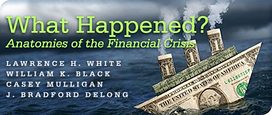Professor DeLong made a list of types of factors that determine asset prices. He went through the list one by one, purporting to show that most of them are negligible when applied to 2008, and then by default assigns causation to the remaining. The risk of his exercise is that it might miss something fundamental, and thereby assign too much to the residual “financial accelerator.”
We live a world large enough that something fundamental might happen that is not immediately obvious from my desk in Chicago, or even from Professor DeLong’s desk in Berkeley. But I am surprised that Professor DeLong neglected the role of new capital goods prices and their effect on the quantity and price of capital assets. After all, Professor DeLong has written one of the most cited papers on this subject.
Just to remind readers of the theory — a higher price for new capital goods raises the price of existing capital assets and reduces the quantity of new investment. A lower price for new capital goods reduces the price of existing capital assets and increases the quantity of new investment. This theory has nothing to do with “financial accelerators.”
It seems obvious that new capital goods (esp. new structures) became expensive during the housing boom, or at least slowed down the rate at which they had been getting cheaper over time. Nonresidential investment had to compete with housing for resources, so in theory this competition reduced nonresidential investment and increased the market value of existing nonresidential capital (e.g., the S&P 500). In theory, this process reversed itself when housing crashed. Specifically, in 2007-8, resources were released from housing construction, which reduced new capital goods prices, encouraged nonresidential investment, and reduced the market value of existing nonresidential capital (eg., reduced the S&P 500).
Luke Threinen and I wrote a paper about this in October. The figures below are from that paper, and from some of my blog entries on the subject.
[Click on figures below to see larger versions.]
The first one shows BEA investment in residential and nonresidential structures, each measured as an index. The second shows detrended construction spending, each measure as year 2000 dollars deviated from trend. Clearly the effect I’m talking about is first-order. Thanks to the end of the housing boom, nonresidential investment can boom again. This doesn’t happen because the managers of nonresidential businesses are general equilibrium thinkers, but merely because new capital goods are cheap.
The third figure is a time series index for nonresidential investment prices (including structures, equipment, and software). Economists have watched this series head downward for decades (e.g., see Gordon, 1990); Figure 3 shows how the housing boom may have interrupted that trend. Because our economic logic is that housing prices affect residential investment which then impacts the price of non-residential capital, it is important to note that nonresidential investment prices peak in the third quarter of 2006. By this measure, the price of non-residential capital falls by 4 percent from its peak, although less relative to trend. Given the continued reduction in housing construction, investment goods prices probably have fallen more in recent quarters (we made this figure when 2008 Q2 was the most recent national accounting data) and still have more to fall; an update of this figure could show investment goods prices down five or six percent.
The market value of existing capital can be measured in financial markets by the sum of the market value of debt and equity. Equity is the residual claimant (that is, stockholders have a leveraged claim on the business assets), so each percentage point change in the market value of capital creates more than a percentage point change in equity values. So the figure is easily consistent with a 10 percentage point change in equity values.
Professor DeLong knows better than I that true investment goods prices fluctuate more than the measured ones, especially in the short term, in part because of unmeasured price discounts offered by investment goods manufacturers, and in part because waiting times need to be included in the full price of an investment good. Thus, the true price of new investment goods probably fell more than five percent and the corresponding reduction in the market value of equity should have been more than 10 percent.
In fact, equity prices fell 40 or 50 percent (I will not attempt to provide a precise percentage, because that may change significantly during the time it takes me to type this sentence). The price of new investment goods cannot explain everything; it is obvious that a changing preference for safety and liquidity has a lot to do with asset price changes and volatility in 2008. But we have hard evidence that Professor DeLong exaggerated the role of financial accelerators, evidence that was quickly found without moving from my desk in Chicago. Is it possible that evidence of further exaggeration might lie elsewhere on this Earth? I expect so.




